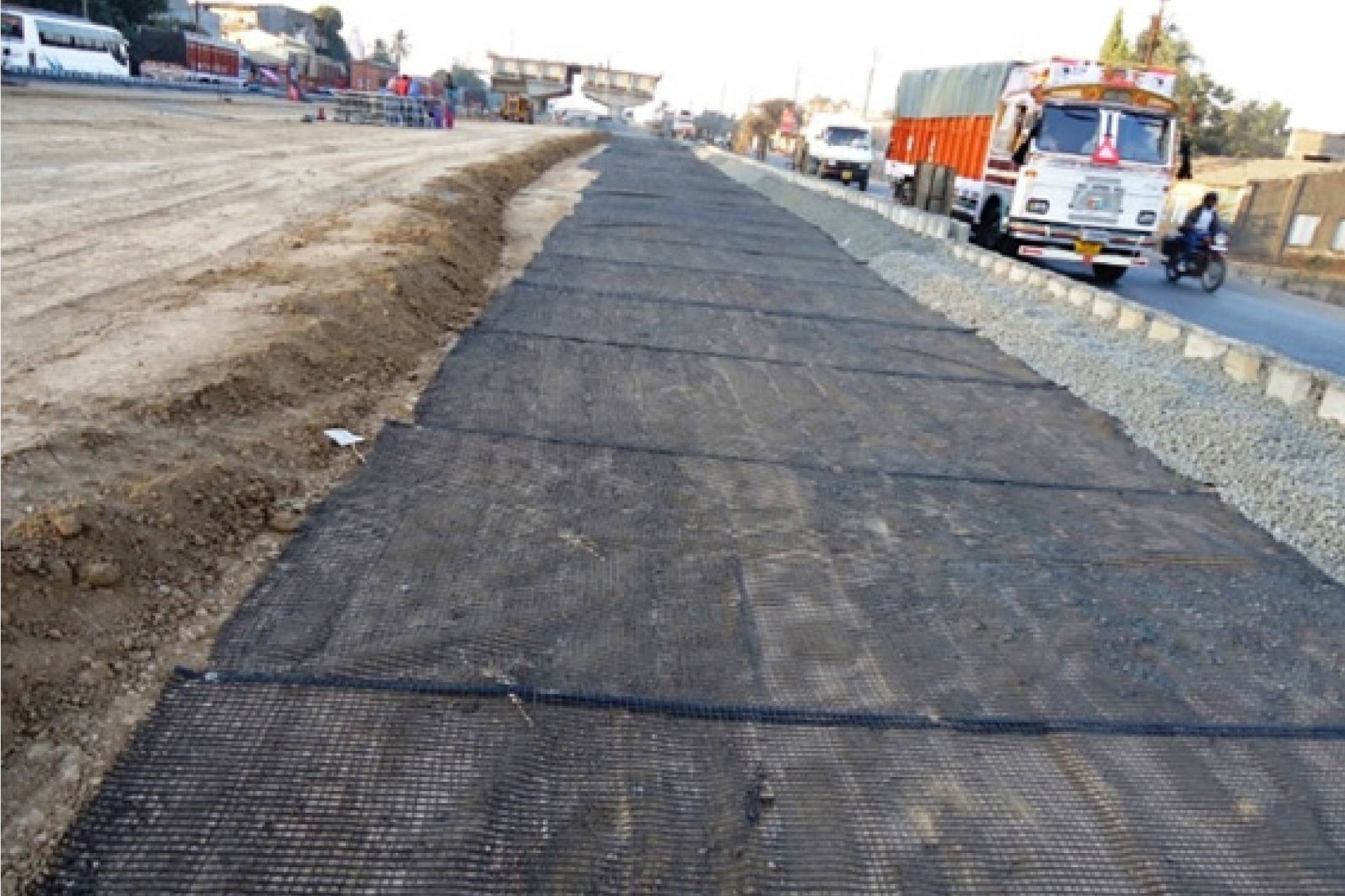Geosynthetics give long-lasting roads, cut maintenance cost
By Edit Team | June 15, 2019 7:23 am SHARE

Geosynthetic products improve stress-bearing capacity, strengthening roads and making them safer.
In India, infrastructure developments are at their highest peak at present and continued to be on peak in future. For the speedy and safer execution of such infrastructure projects there are huge demands of advanced and innovative solutions in various civil engineering applications. One of them is use of geosynthetics in roads. In case of roads, there are various applications where we can use these products to increase the speed of construction, optimise project cost, and help construct roads over problematic site condition without compromising on safety.
There are many problems associated with road construction such as alignment of roads through problematic ground conditions, constructions of roads nearby coastal area for better connectivity with the ports, also the scarcity of natural resources (stone, sands, gravel, etc.), and high ground water table and drainage issues encounter. To deal with such conditions, there are different geosynthetic products available which can make the road stronger and safer with long life and lower maintenance cost, says Manish Barot, Head – Technical Sales and Business Development, Techfab India Industries Ltd.
There are two types of pavements such as flexible and rigid. Geosynthetics are often used for flexible pavements. The flexible pavement is a structural entity comprising of components of granular material of different gradations (base course and sub-base course), placed on the dressed original (or even backfilled) soil, called sub-grade. Normally, a flexible road pavement suffers two types of failures; rutting and fatigue cracking. According to Shahrokh Bagli, Chief Technology Officer, Strata Geosystems (India) Pvt Ltd, if the sub-grade soil is weak, there will be excessive vertical strains at the interface of the pavement and the sub-grade, resulting in rutting.
The pavement components need to be stronger to carry the wheel loads several million times over, during the proposed life of the pavement. One way of achieving this weak sub-grade is to judiciously increase the thickness of the pavement components. This is an expensive proposition and in present times, not conducive to the environment with restrictions on quarrying of natural materials. If there are excessive horizontal strains between the surface course (invariably bituminous), there will be surface fatigue cracks (also called alligator cracks).
The introduction of polymeric geosynthetics, essentially geo-cells and often geo-grids, improve moduli in the respective layer that these are placed to provide more economic (thinner) pavement components. This in effect gives economy in design, cost savings and savings in construction time. With the need for less quantity of natural material, use of geosynthetics in flexible pavement sections offer an eco-friendly solution.
Geosynthetics prevent lateral spreading of the sub-base, helping in soil confinement and improving the vertical stress bearing capacity of the soil. “It has been proven that effective use of geo-textile and geo-grid increases load bearing capacity of soil up to 50 per cent. Hence, roads become strong and long lasting,” says Kartik Kanodia, Director, Manas Geo Tech India Pvt Ltd.
Use of non-woven geo-textile acts as a filter media between the sub-base and aggregate, non-woven geo-textile allows water to freely pass through its surface thus acts as a filter media by preventing different layers of soil from intermixing and allows sedimentation of soil.
“We make the material in such a manner that AOS (apparent opening size) is always smaller than the finer soil particles hence, allows water to freely pass through its surface and preventing soil from passing. This function helps to prevent pot holes and bumps which make the road safer and durable,” says Kanodia.
Applications
An eco-friendly way is to reinforce the pavement components with polymeric geosynthetic reinforcement. There are two types of reinforcements for the flexible pavement; geo-cells and biaxial geo-grids. Each has its own functional philosophy.
Geo-cells are three-dimensional curvilinear rhomboidal confining elements. Geo-cells confine the material within which it is laid. Owing to such confinement, it improves the performance of the road by enhancing the resilient modulus of the component within which the geo-cell layer is placed by 2.5 times, at times even more than three times, says Bagli.
Biaxial geo-grids are those with equally high-strength ribs in both machine and cross-machine directions. The performance of biaxial geo-grids is different. It holds the material together either by friction (flexible geo-grids) or interlocking (rigid geo-grids), Bagli adds.
Below is a list of geosynthetic materials and their applications by Kanodia:
• Geo-textile: Geo-textile can be either woven or non-woven. Woven geo-textile is used for slope stabilisation and where heavy reinforcement is required like under railway tracks. Non-woven geo-textile on the other hand is used in almost all road projects due to their excellent hydraulic and reinforcement properties. It helps in separation, re-enforcement, drainage and filtration.
• Geo-grids: Geo-grids are polymers in an open grid like configuration mainly used for re-enforcement in the soil, roads, railways and re-walls. There are two types of geo-grids such as uni-axial (stretched in one direction) and biaxial (stretched in two directions).
• Geo-membrane: Geo-membranes are impervious sheets of polymeric material mainly used for lining and covers for landfills, canals, tunnels and other containment facilities. Main function is to contain water or vapour preventing it from escaping through its surface.
• Geo-cells: Geo-cells are three dimensional honeycomb cellular structures which are used for confinement of the soil. This helps to reduce the lateral movement of soil particles, thereby maintaining compaction and forming a stiff mattress that distributes the load of the vehicles to a wider area.
• Geo-composite: Geo-composite is a sandwich material of geo-textile, geo-grids and geo-membrane. For example, geo-net along with geo-textile has excellent drainage capabilities and is being used in re-wall replacing the traditional gravel media.
“Techfab India is geared up to provide geosynthetic products to deal with different geotechnical solutions where conventional solutions have their limitations. In last couple of years, Techfab India has added additional manufacturing facilities for following products which are the present need of industries,” says Barot.
TechGrid PP biaxial geo-grid
TechGrid PP Biaxial is an integrally formed biaxial geo-grid that has been manufactured using punched and drawn procedure using quality polypropylene. The main applications of the TechGrid are base and sub-base stabilisation in pavement, track-bed stabilisation in railway and soil reinforcements.
TechDrain drainage composite
A drainage composite TechDrain is used for drainage in pavement and retaining structures. It is a combination of a geo-net and non-woven geo-textile. The geo-textile used here is either needle punched or a thermally bonded non-woven geo-textile, and the net or core used in between the two geo-textiles or the one side geo-textile is made up of high density polyethylene (HDPE).
TechCell geo-cell
TechCell is a light weight yet strong, 3D honeycomb like cellular confinement system, which offer unique, eco-friendly solution for various civil engineering challenges. Techcell geo-cell are widely used in construction for erosion control, soil stabilisation on flat ground and steep slopes, channel protection and structural reinforcement for load support and earth retention. Typical cellular confinement systems expanded on-site to form a honeycomb-like structure and filled with sand, soil, rock, gravel or concrete or available local soil or recycled materials.
Techfab India is geared up to provide geosynthetic products to deal with different geotechnical solutions, where conventional solutions have their limitations.
Manish Barot, Head – Technical Sales and Business Development, Techfab India Industries Ltd
Pavement components need to be stronger to carry wheel loads several million times over, during the proposed life of the pavement.
Shahrokh Bagli, Chief Technology Officer, Strata Geosystems (India) Pvt Ltd.
It has been proven that effective use of geo-textile and geo-grid increases load bearing capacity of soil up to 50 per cent. Hence, roads become strong and long lasting.
Kartik Kanodia, Director, Manas Geo Tech India Pvt Ltd.
Cookie Consent
We use cookies to personalize your experience. By continuing to visit this website you agree to our Terms & Conditions, Privacy Policy and Cookie Policy.




















































